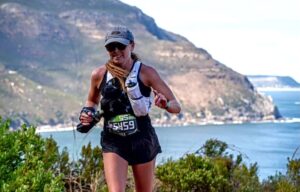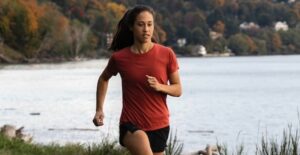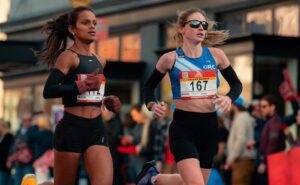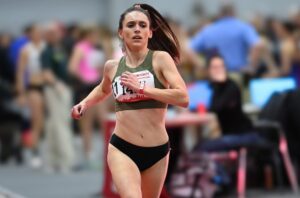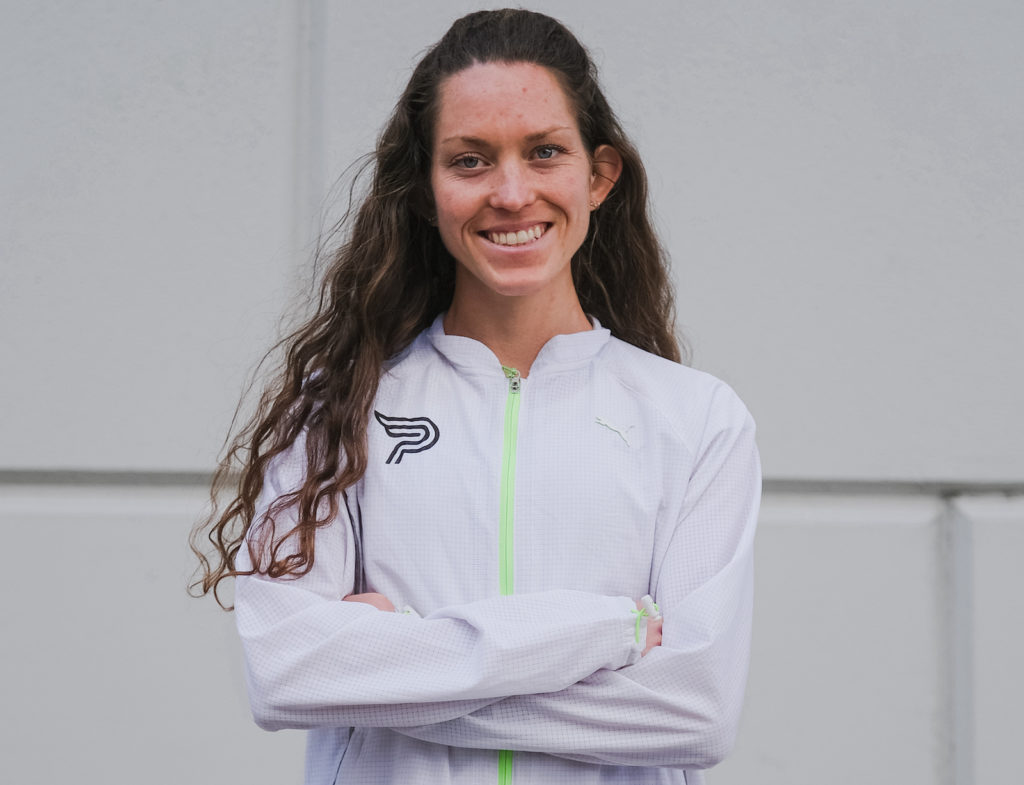
By Alison Wade
In the early miles of the Houston Half Marathon on January 16, Fiona O’Keeffe glanced down at her watch and noticed a mile split that was just over five minutes. It was faster than she expected to be running. As the pack of women she was running with continued to click off quick splits, she stuck with them, because she was feeling pretty good. She decided not to overthink the numbers on her watch and just focus on racing the women around her.
“I didn’t want to sell myself short,” O’Keeffe told Fast Women. “I was okay with going out a little hard and potentially having to dial it back later. But I kept feeling okay longer than I expected, so it was like, ‘Okay, I’m just going with it.’”
O’Keeffe’s coaches, Amy and Alistair Cragg, were a bit nervous when they saw her 5K split (16:03) online, but as soon as they caught a glimpse of her on the TV broadcast, saw how strong and confident she looked, and they knew she was going to be fine. O’Keeffe’s training the past few months had been spectacular and indicated she was ready to run fast. While they would normally advise caution in a half marathon debut, especially because O’Keefe is only 23, they had told her to trust herself. “When you have an athlete who has trained that well, you don’t want to hold them back,” said Amy Cragg. “You want to let them utilize that opportunity and see what they can do.”
O’Keeffe’s naivete may have helped. Because she hadn’t raced a half marathon before, she didn’t have a good sense of what any given pace meant. And she’s glad she didn’t see her 31:54 10K split until after the race, because it was 18 seconds faster than her personal best, and she still had more than half the race to go. But her training had given her confidence.
“Around mile nine or 10, I think it was Dom Scott’s coach that was yelling at us, because the two of us were running together at that point,” O’Keeffe said. “He was saying, ‘You guys are going to break 68 minutes for the half,’ and a little while later, someone said, ‘Sara [Hall] is on American record pace right now.’ Then I was like, ‘Okay, wow, we’re going to have a really good day today.’ That was really exciting.”
O’Keeffe could still see Hall up ahead when she got that feedback, and Hall did go on to break the American record by 10 seconds, finishing second in the race in 1:07:15. Race winner Vicoty Chepngeno of Kenya was in a league of her own, running 1:05:03, the fastest time ever on U.S. soil.
Scott, who represents South Africa and Team Boss, put some distance on O’Keeffe in the closing stages of the race, finishing third in 1:07:32, and O’Keeffe finished fourth, in 1:07:42 (5:10/mile). It was the fastest record-legal debut half marathon ever by a U.S. woman. And she became the fifth-fastest woman from the U.S. ever to run the distance. (Kara Goucher ran 1:06:57 in her half marathon debut at the Great North Run in 2007, but it’s not record-eligible because of the point-to-point downhill course.)
“I definitely was not expecting that performance,” O’Keeffe said. “You never know what might be there on race day and the flip side of not having any expectations is also not putting limits on yourself. You don’t want to decide before the race that you can’t do something; you never know what might happen.”
Joining Puma Elite
O’Keeffe was a three-time California state champion and part of a strong team at Davis High School. (Her coach there, Bill Gregg, has two children, Kaitlin Goodman and Brendan Gregg, who also went on to run professionally.) She attended Stanford, where she was a four-time All American in cross country, with a highest finish of 13th in 2017. She was a three-time first-team All American in track, with a highest finish of third in the 2019 indoor 5,000m. O’Keeffe’s senior year was interrupted by the onset of the pandemic, and she graduated, virtually, from Stanford late in the spring of 2020.
Because O’Keeffe still had collegiate eligibility remaining, she decided to use it at the University of New Mexico, where her younger sister Olivia was already part of the team. O’Keeffe moved to Albuquerque and began a graduate program in the fall of 2020. She had a good experience in Albuquerque, but she began to realize she felt more enthusiastic about training and racing than she did about graduate school.
In early December of that year, running unattached, O’Keeffe ran 32:12.28 for 10,000m, a big personal best, which qualified her to compete at the U.S. Olympic Track & Field Trials. She heard about the professional training group Puma was forming in Chapel Hill, North Carolina, coached by the Craggs. She knew former Arkansas standout Taylor Werner was joining the group, and the more she learned, the more she was sold.
O’Keeffe left graduate school and in January of 2021, she moved straight to the team’s altitude camp, with just one suitcase. Her transition to professional running was rocky. In February, she started having issues with her plantar fascia, and by March, she had developed a metatarsal stress fracture. O’Keeffe remembers talking to two of her former Stanford teammates, Elise Cranny and Vanessa Fraser, around that time. “They did a great job of reassuring me that it was normal for that transition to be a little bit bumpy. They [discussed] trusting yourself throughout that process as well, basically telling me that it all does work out, even if it doesn’t feel like it in the moment,” she said.
O’Keeffe cross-trained for six weeks and was able to start running on land (vs. an anti-gravity treadmill) by the end of May. But the Olympic Trials were fast approaching. She managed to get a couple weeks of solid track workouts in before the 10,000m final on June 26, so she decided to give it a shot.
“I didn’t think I was going to go out and make the team or anything like that, but I wanted to get the experience and I was really glad that I was able to,” said O’Keeffe. “The 10K was probably the hardest race I’ve ever run, but I’m really glad that I was able to be there and test myself in that way.”
The start of the 10,000m was moved up two hours because of unusually hot and humid weather in Eugene, Oregon, but even with the earlier start, the conditions were oppressive. O’Keeffe finished 20th, in 33:03.09. O’Keeffe, who studied environmental science in college and is passionate about climate change, ended her Instagram post about the race with a postscript: “The frequency and severity of extreme weather events like the heat we experienced in Eugene is accelerating with climate change,” and added the hashtag #DontForgetToVote. “I think there’s going to be a lot more overlap in the future as we see climate change accelerating and affecting running events, unfortunately,” she said.

Gaining ground
Since coming back from her injury, O’Keeffe has been making steady progress. She did a lot of road racing over the summer and into the fall, with a training break in August. She thinks the Falmouth Road Race, where she finished third behind Edna Kiplagat and Emily Durgin, was probably her strongest race until Houston.
O’Keeffe has been a pro runner for roughly one year now. “I’ve just been learning so much this whole year,” she said. “There’s a lot you learn every time out there on the roads and I feel like it really helped me learn to be a little more adaptable and make those race decisions on the fly. I think that was also a big contributing factor to being able to do what I did in the half.”
She has been building her weekly mileage throughout her career, and it now tends to hover in the 80s and 90s. O’Keeffe’s workouts have also changed. “We’re a pretty strength-based program and the volume of work has definitely gone up,” she said. “That’s probably the biggest change.”
O’Keeffe is turning her attention back to the track now, with a focus on the 10,000m. She’s looking forward to seeing what she can do with the fitness she displayed in Houston. She hopes to run both the 10,000m and the 5,000m at the USATF Outdoor Track & Field Championships. The former will be held May 20 at Mt. San Antonio College in Walnut, California; the latter will be held June 23–26 at Hayward Field in Eugene, Oregon.
And with a great half marathon performance, there will always be questions about moving up to the marathon. O’Keeffe says she will, but not yet.
“I really enjoyed the experience of having that big marathon feel and getting to be out on the roads for longer, so I think it made me more excited about doing [a marathon] in the future, but I’d imagine that’s still a couple years off,” she said.
Cragg said O’Keeffe’s training has been geared toward the 10,000m, which will remain her focus. The half marathon was just a stop along the way. But O’Keeffe has adapted to the longer workouts easily. “With Fiona, it was just like you put her in these longer workouts and all of a sudden, she’s just found herself. She’s home,” Cragg said. “It’s really fun to watch that and it makes me very, very excited for her future in the marathon, and on the track, too. I think she’s going to surprise some people this year.”
But Cragg is in no rush for O’Keeffe to move up, especially because she’s so young. “We’re not going to try to push her towards that too early and risk what she can do five or six years from now,” she said. “We’ll do it when she’s ready and when the training indicates that she’s ready, but we’re going to be really careful about it.”
—
To have content like this delivered to your inbox each Monday morning, subscribe to the Fast Women newsletter here.



